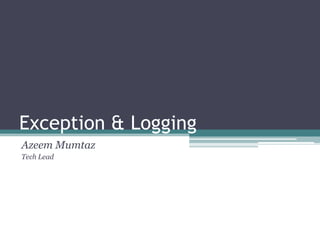
Logging and Exception
- 1. Exception & Logging Azeem Mumtaz Software Engineer
- 2. Introduction • Why Exceptions? ▫ To describe exceptional circumstances ▫ To interrupt the current flow • In Java ▫ Exception are thrown and caught
- 3. Exception Class Hierarchy Throwable Error Exception RuntimeException IOException ArithmeticException FileNotFoundException
- 4. Types of Exception • Within JVM there are 2 types of exceptions ▫ Checked Enforced by methods ▫ Unchecked May lead to thread unraveling and poor visibility
- 5. Catching Exceptions • Try ▫ Tells that the enclosed code segment could raise a potential exception • Catch ▫ What exceptions to handle ▫ If no catch for a checked exception, the compiler will generate an error.
- 6. Guaranteed Execution of Cleanup Code • To write code that executes when control leaves a code segment ▫ Finally
- 7. Throwing Exceptions • Making account for an exceptional problem by throwing an exception • The execution will not continue on current code path
- 8. Catching Multiple Exceptions • Using different catch clauses ▫ Most-Specific to Most-General • A new Java construct ▫ “|” operator ▫ Java 7 Feature • Pokemon® Exception ▫ catch (Exception e) ▫ Catches every exception type and treat them same ▫ May catch unwanted exceptions (i.e. OutOfMemoryException)
- 9. Catching the Uncaught Exceptions • How to know when a thread is being terminated because of an uncaught exception? ▫ Register an ExceptionHandler Per thread Thread.currentThread().setUncaughtExceptionHandler Globally Thread.setDefaultUncaughtExceptionHandler
- 10. Managing Resource with try/catch • Why? ▫ Managing resources problematic ▫ Should properly dispose once used ▫ Limited and cause performance degradation • ARM ▫ Automatic Resource Management ▫ Java 7 ▫ Try-with-resource block ▫ java.lang.AutoClosable
- 11. Creating an Exception Class • extend RuntimeException ▫ Unchecked exceptions ▫ But, Leads to poor exception handling • extend Exceptions • Rule of Thumb: ▫ If it’s possible to recover from an exception, extend the Exception class. ▫ Else, if it is not reasonable to expect to be recovered from the exception (i.e. NullPointerException), extend RuntimeException.
- 12. Re-throwing the Caught Exception • With Java 7, JVM will bubble the exception to the appropriate type • Checked exceptions have to be defined in the method declaration
- 13. Logging Events • SLF4J ▫ A Simple Logging Facade for Java ▫ An abstraction for various logging frameworks Java Logging API Log4j Jakarta Commons Logging
- 14. log4j • Enabling logging at runtime • Fully Configurable at runtime via external configuration file • Gentle learning curve • 3 Main Parts ▫ Loggers ▫ Appenders ▫ Layouts
- 15. log4j • Logger ▫ Named entities ▫ Has a naming hierarchy ▫ Provides run-time control on which statements are printed or not ▫ Root logger It always exists It cannot be retrieved by name Logger.getRootLogger ();
- 16. log4j • Log Levels - http://goo.gl/jOWg8 ▫ TRACE ▫ DEBUG Messages in this level contain extensive contextual information. They are mostly used for problem diagnosis. ▫ INFO contain some contextual information ▫ WARN a potential problem in the system – i.e. a security valnarability ▫ ERROR ▫ FATAL • Level inheritance • A logging request is said to be enabled, ▫ If the level of the logging request >= logger’s log level
- 17. log4j • Basic Selection Rule ▫ A log request of level p in a logger with (either assigned or inherited, whichever is appropriate) level q, is enabled if p >= q. • TRACE < DEBUG < INFO < WARN < ERROR < FATAL
- 18. log4j • .getLogger(…) ▫ Will always return a reference to the exact same object • Log4j makes it easy to name loggers by software component ▫ statically instantiating a logger in each class ▫ Logger name as the class name ▫ A way to define loggers The origin of the log message is easily identified
- 19. log4j • Loggers • Appenders ▫ log4j allows logging requests to print to multiple destinations ▫ An output destination is called appender. Currently appenders exists for; Console Files GUI Components Remote Sockets, Servers, JMS, NT Event Loggers, Syslog Daemons Logging Asynchronously
- 20. log4j • Appenders ▫ Each enabled logging request for a given logger will be forwarded to all the appenders in that logger as well as the appenders higher in the hierarchy • Appender Additivly ▫ The output of a log statement of logger C will go to all the appenders in C and its ancestors. ▫ Additivity flag
- 21. Cons log4j ole root S X File X.Y X.Y. Z
- 22. Cons log4j ole root S X File Aditivity = false X.Y X.Y. Z
- 23. log4j • Loggers • Appenders • Layout ▫ Customizes log output format ▫ Conversion pattern like C languages printf ▫ http://logging.apache.org/log4j/1.2/apidocs/org/ apache/log4j/PatternLayout.html ▫ Ex: conversion pattern “%r [%t] %-5p %c - %m%n [%x]” 176 [main] INFO org.foo.Bar - Hello World [1581616 4464 116416 1161]
- 24. log4j • Nested Diagnostic Contexts (NDC) • Performance and Best Practices ▫ Log message parameter construction ▫ logger.isDebugEnabled ▫ Choose appropriate logging level ▫ Log message format ▫ Logging in a production environment Logging sensitive data Log file management Correlating specific execution order
- 25. Thank You
Notas do Editor
- Clean Code
- OutOfMemoryException
- UncaughtExceptions
